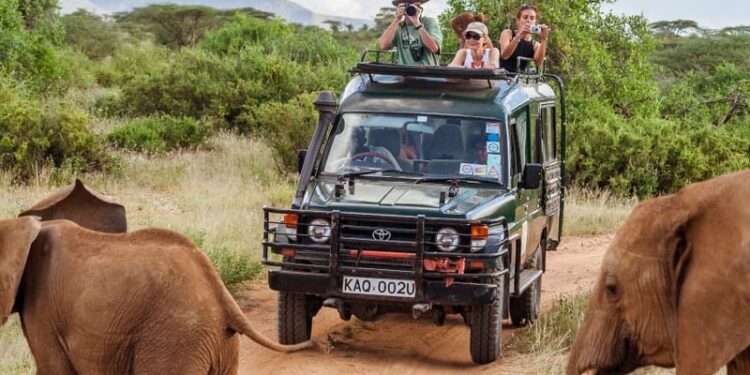The Global Wildlife Tourism Market is projected to reach approximately USD 316.2 billion by 2033, up from USD 150.6 billion in 2023, with a compound annual growth rate (CAGR) of 7.7% during the forecast period from 2024 to 2033. Wildlife tourism includes travel to natural areas where individuals can observe and interact with wildlife in their habitats, engaging in activities such as safaris, birdwatching, and nature photography. This sector emphasizes conservation and sustainable practices, providing unique experiences for environmentally conscious travelers while supporting local economies and conservation efforts.
The wildlife tourism market encompasses the industry that offers travel services, accommodations, and experiences centered around wildlife interactions. It includes eco-lodges, safari tours, and conservation-based tourism, catering to travelers seeking eco-friendly and educational experiences. This market is increasingly contributing to global tourism revenues and funding for conservation initiatives.
Demand for wildlife tourism is on the rise due to a growing interest in sustainable and nature-centric travel. The United Nations World Tourism Organization (UNWTO) reports that 1.3 billion international tourists traveled worldwide in 2023, a significant increase of 33.4% over 2022. This trend reflects a broader movement toward eco-tourism, with 83% of travelers prioritizing sustainability in their travel choices. The increasing interest in eco-friendly experiences is driving the continued expansion of the wildlife tourism market.
Key Insights into the Wildlife Tourism Market:
- The market was valued at USD 150.6 billion in 2023, with expectations to grow to USD 316.2 billion by 2033, achieving a CAGR of 7.7%.
- In 2023, safari tourism led the market, as many travelers seek close encounters with wildlife.
- Direct bookings accounted for 60.2% of the market in 2023, highlighting a trend toward personalized travel planning.
- Group travel was favored by 40.4% of tourists, reflecting the demand for shared wildlife experiences.
- The Asia Pacific region commanded a 49.6% market share, bolstered by biodiversity hotspots in India and Southeast Asia.
Analysis of the Wildlife Tourism Business Environment:
The wildlife tourism market is steadily growing, showing moderate saturation in established destinations but offering significant opportunities in underdeveloped regions. For instance, Zambia allocates 30% of its land to national parks, presenting potential for expansion. Tanzania has invested over 60 billion Tanzanian shillings in Ruaha National Park, improving facilities and attracting more visitors.
Approximately 60% of wildlife tourists fall between the ages of 25 and 44, representing a younger demographic keen on eco-adventures and conservation travel. About 65% of these travelers have above-average incomes, which allows them to spend more on premium wildlife experiences, driving demand for exclusive and sustainable offerings.
As competition increases, product differentiation has become vital. Initiatives by the Kenya Wildlife Service and eco-resorts in India illustrate how private investments and luxury options can enhance the appeal of wildlife destinations. Investments in wildlife tourism are on the rise, as governments aim for sustainable economic growth. Kenya plans to increase its bed capacity substantially, and India expects a significant rise in branded hotel rooms near wildlife destinations by 2025.
International tourism plays a crucial role in export-import dynamics and supports foreign exchange earnings. For example, Kenya experienced a 72% increase in international visitors last year. In contrast, domestic tourism is thriving in India, where 70% of wildlife destination visitors are local.
Adjacent markets like eco-tourism and adventure tourism complement wildlife tourism, creating opportunities for broader growth. According to the UNWTO, 75% of wildlife tourists prefer destinations that emphasize conservation and ethical wildlife interactions, signaling a sustainability-focused trend in consumer behavior.
Regional Breakdown of the Wildlife Tourism Market:
- Asia Pacific: Leads with a 49.6% market share, valued at USD 74.70 billion. Key countries include India, Thailand, and Australia, known for their diverse wildlife and eco-tourism initiatives.
- North America: Features iconic locations such as Yellowstone National Park and the Canadian Rockies, with activities like grizzly bear viewing and whale watching.
- Europe: Offers diverse wildlife experiences and benefits from strong conservation policies and eco-friendly travel options.
- Middle East & Africa: Emerges as a wildlife hub, with safari destinations and conservation projects attracting global tourists.
- Latin America: Gains traction with eco-tourism initiatives and unique wildlife experiences, like those found in the Amazon Rainforest.
Tourism Types in the Wildlife Market:
- Safari Tourism: Dominates with 45% market share, known for its unique wildlife experiences and strong global appeal.
- Group Travel: Leads with 40.4% of the market, highlighting a preference for shared experiences that enhance enjoyment and reduce costs.
- Independent Travel: Significant among travelers seeking flexibility and personalization.
- Couples Travel: Offers specialized packages for romantic getaways and intimate wildlife experiences.
This comprehensive analysis of the Global Wildlife Tourism Market identifies significant trends and factors contributing to its growth, showcasing the continued interest in sustainable and immersive travel experiences centered on wildlife encounters.








































































